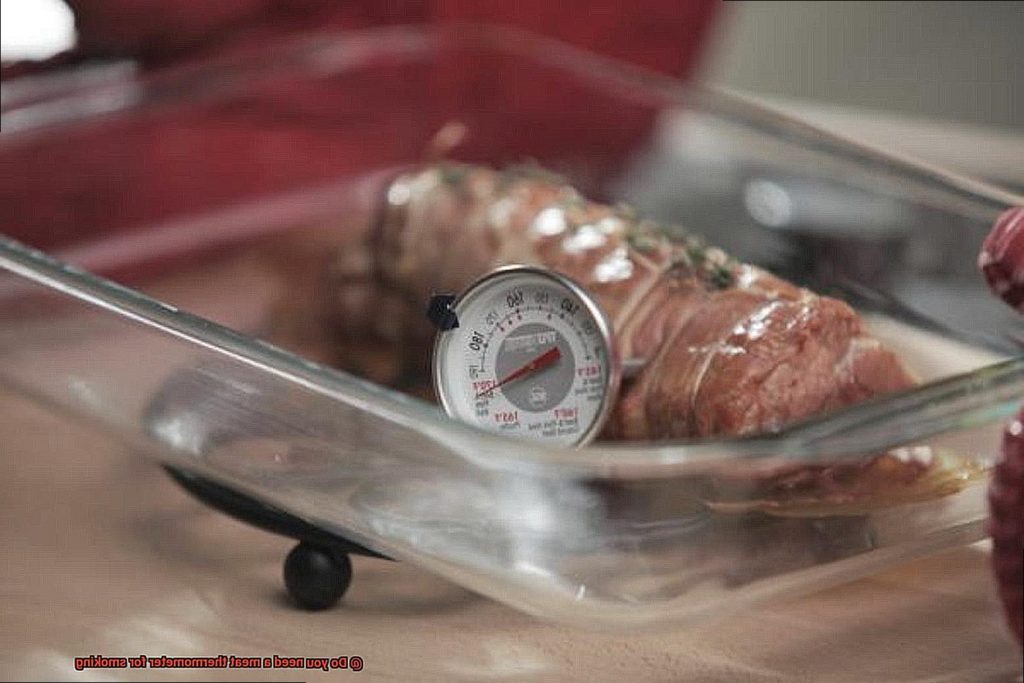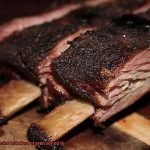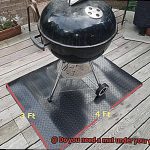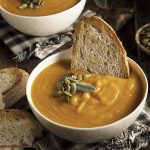Imagine this: a glorious summer day, the tantalizing aroma of smoke swirling around you, and a slab of meat slowly transforming into barbecue perfection in your smoker. As you eagerly await that first bite, there’s one tool that can make all the difference between culinary triumph and disappointment – a meat thermometer.
Now, you might be wondering, “Do I really need a meat thermometer for smoking?” The answer is an emphatic yes. Smoking meat is an art form that requires mastering temperatures, seasonings, and cooking times. But don’t underestimate the crucial role accuracy plays in achieving perfectly cooked cuts.
In this blog post, we’re going to dive headfirst into why a meat thermometer is your ultimate sidekick during your smoking adventures. From ensuring food safety to unlocking mouthwatering flavors, we’ll uncover the untold benefits that will have you reaching for this indispensable tool every time you fire up your smoker.
So grab your favorite beverage, settle into your smoking chair (we know you have one), and prepare to unlock the secrets of the mighty meat thermometer. Get ready to take your smoking game to new heights as we explore why this simple device is an absolute game-changer for any pitmaster worth their salt (or rub).
Contents
What is Smoking Meat?
Smoking meat is not just a cooking technique; it’s an art form that has been passed down through generations. The process of slow-cooking meat over low heat with the infusion of smoky flavors creates tender and succulent dishes that are hard to resist. In this article, we will explore the basics of smoking meat, including equipment, wood selection, and the benefits it offers in the culinary world.
Choosing the Right Equipment:
Embarking on your smoking adventure requires the right equipment. A smoker or a grill with a smoker box is essential. There are various types available, such as charcoal smokers, electric smokers, pellet smokers, and offset smokers. Each type has its own advantages and disadvantages, so choose one that suits your needs and preferences.
The Role of Wood:
Wood plays a vital role in the smoking process as it provides the smoky aroma and taste. Different types of wood produce different flavors, ranging from mild to strong. Popular options include oak for a bold flavor, hickory for a strong and bacon-like taste, mesquite for a rich and earthy flavor, applewood for a sweet and fruity touch, cherrywood for a mild and slightly sweet taste, and pecan for a nutty and aromatic flavor. Experimenting with different wood varieties can create unique flavor profiles for your smoked meats.
The Slow-Cooking Process:
Smoking meat is a slow and patient process. The key is to maintain a consistent low temperature between 200°F and 250°F (93°C to 121°C). This allows the meat to cook slowly over an extended period, breaking down tough connective tissues and resulting in tender and flavorful dishes. The smoke from burning wood or charcoal penetrates the meat, infusing it with its distinct smoky essence.
Cuts of Meat:
When it comes to smoking meat, there is an array of cuts to choose from. Tender cuts like brisket, ribs, pork shoulder, and chicken thighs are popular choices due to their ability to absorb flavors and become meltingly tender. Cured meats like bacon and ham also benefit greatly from the smoking process, enhancing their taste and preserving them.
The Art of the Bark:
One of the unique features of smoked meat is the formation of a delicious crust or bark on the exterior. This is achieved through the Maillard reaction, which occurs at high temperatures and results in a flavorful and caramelized outer layer. The bark adds texture, depth, and a burst of flavor to every bite.
Benefits of Smoking Meat:
Aside from the incredible flavor, smoking meat offers several benefits. The slow-cooking process ensures that the meat remains moist and juicy, while also allowing it to develop complex flavors. Smoking can also help preserve meats by inhibiting bacterial growth. Additionally, smoking imparts a smoky aroma that enhances the overall sensory experience of enjoying a perfectly smoked piece of meat.
What Internal Temperatures Are Required for Different Types of Meat?
Smoking meat is a culinary art that combines flavor infusion with the creation of tender, juicy cuts. To ensure a safe and perfectly cooked result, understanding the internal temperatures required for different types of meat is crucial. In this article, we will explore the ideal internal temperatures for various meats when smoking, guaranteeing a mouthwatering outcome every time.
Beef:
Beef enthusiasts rejoice. From succulent brisket to juicy steaks, achieving the perfect doneness is an art form. For those who prefer their beef rare, aim for an internal temperature of 125°F (51.7°C), allowing the meat to retain its vibrant pink center.
Medium-rare beef lovers should go for around 135°F (57.2°C), offering a delicate balance of tenderness and juiciness. For a bit more firmness, medium beef requires about 145°F (62.8°C), while those seeking a touch more doneness can opt for medium-well beef cooked to approximately 155°F (68.3°C). For well-done beef enthusiasts, a minimum internal temperature of 160°F (71.1°C) or higher will ensure a thorough cook, though sacrificing some tenderness.
Pork:
Pork shoulder or pork butt, ideal for creating delectable pulled pork, should be smoked until it reaches an internal temperature of around 195°F to 205°F (90.6°C – 96.1°C). This slow cooking process allows the tough connective tissues to break down, resulting in melt-in-your-mouth tenderness. However, for other cuts like pork chops and tenderloins, the minimum internal temperature should be 145°F (62.8°C) to ensure they are fully cooked and safe to eat. Ground pork and sausages require a slightly higher internal temperature of 160°F (71.1°C) to eliminate any potential risks.
Poultry:
When smoking poultry, such as whole chickens or succulent chicken thighs, it is crucial to reach a minimum internal temperature of 165°F (73.9°C). This ensures that harmful bacteria are eliminated, guaranteeing both safety and superior flavor. Achieving this temperature will result in tender, juicy meat that is sure to impress even the most discerning palates.
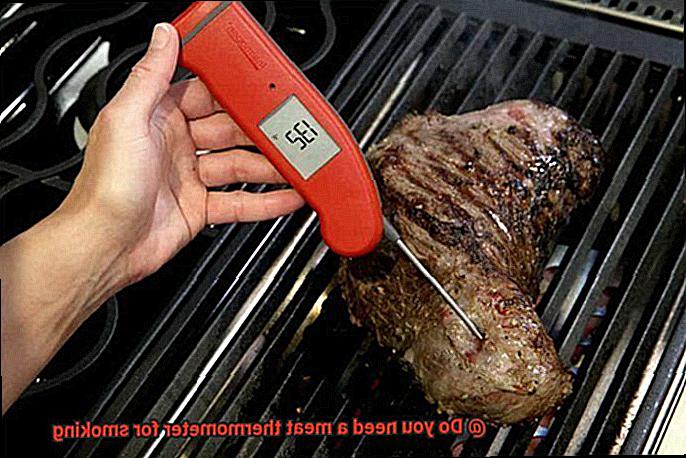
Fish:
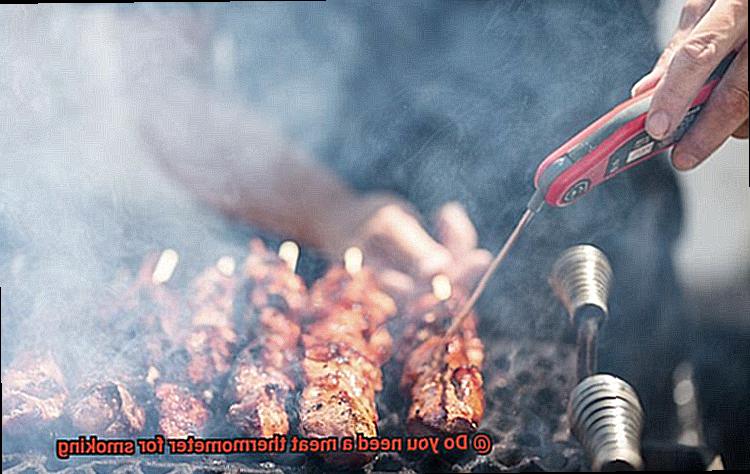
Delicate fish like salmon or trout can be smoked until they reach an internal temperature of around 145°F (62.8°C). At this temperature, the flesh becomes opaque, easily flakes with a fork, and retains its moistness and delicate flavor. Cooking fish to the perfect internal temperature ensures a delightful eating experience that showcases the natural flavors of the sea.
Why Is a Meat Thermometer Necessary for Smoking Meat?
Smoking meat is an art that demands skill, patience, and the right equipment. While the mouthwatering aroma and tantalizing flavors of smoked meats are hard to resist, achieving perfection goes beyond having a smoker and wood chips. Enter the unsung hero of smoking meat: the meat thermometer. In this article, we’ll delve into why a meat thermometer is not just a handy tool, but an absolute necessity for any aspiring pitmaster or backyard griller.
Safety First:
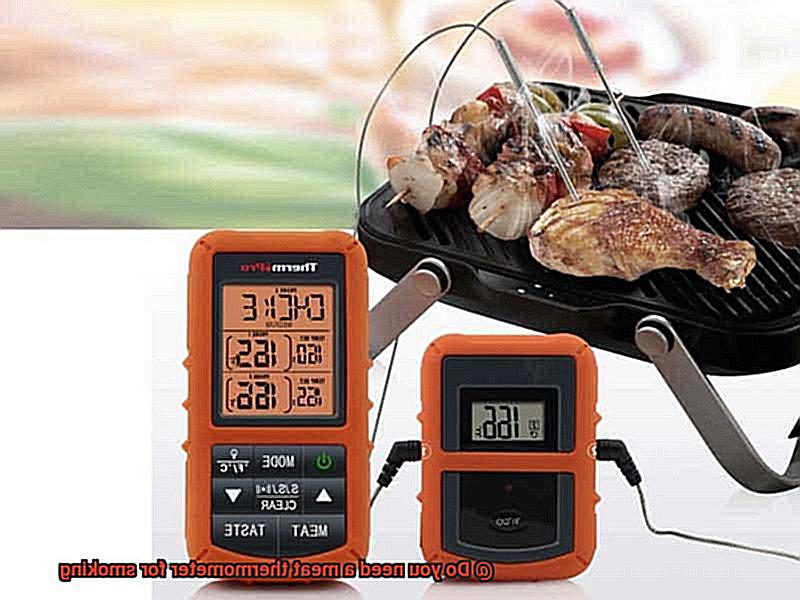
Smoking meat involves cooking at low temperatures over an extended period, creating an ideal environment for bacteria to thrive. Ensuring that your meat reaches the appropriate internal temperature is crucial for eradicating harmful microorganisms and safeguarding yourself and your loved ones against foodborne illnesses.
Taste Matters:
Smoking meat is a delicate balance between achieving tender, succulent perfection and ending up with dry, overcooked disappointment. A meat thermometer allows you to closely monitor the internal temperature of your meat, helping you avoid undercooking or overcooking. By hitting the optimal temperature sweet spot, you can unlock that mouthwatering tenderness and flavor that leaves everyone craving for more.
One Size Doesn’t Fit All:
Different types of meat require different internal temperatures to be deemed safe to eat. With a meat thermometer in hand, you can bid farewell to guesswork, accurately measuring the internal temperature of each cut. For instance, poultry should reach a minimum internal temperature of 165°F (74°C), while pork should hit 145°F (63°C) with a three-minute rest time. Armed with a thermometer, you can confidently serve up safe and delectable smoked meats every time.
Consistency is Key:
Do you aspire to be known as the grilling maestro who consistently nails that perfectly cooked brisket or ribs? A meat thermometer can be your secret weapon, helping you achieve consistent results with different cuts of meat. Each cut may have its own optimal internal temperature for achieving the desired level of doneness or tenderness. With a thermometer, you can accurately gauge these temperatures and replicate your smoking successes.
Trust the Experts:
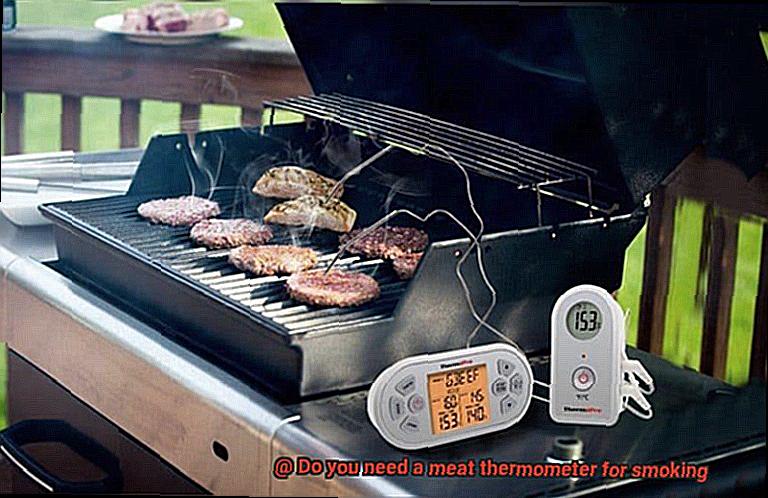
While some smokers come with built-in thermometers, these can be unreliable and less accurate compared to standalone meat thermometers. Investing in a reliable and accurate meat thermometer ensures precise control over the temperature of your smoked meats, providing both peace of mind and culinary confidence.
Different Types of Meat Thermometers
The secret to achieving perfectly cooked meat lies in using a meat thermometer. With a variety of options available, it’s crucial to choose the right one for your grilling adventures. In this article, we will explore the different types of meat thermometers and their unique features and benefits, empowering you to become a grilling pro.
Instant-Read Thermometers: Quick and Accurate
When time is of the essence, an instant-read thermometer becomes your best friend. With a digital display and rapid response time, simply insert the probe into the thickest part of the meat. Within seconds, you’ll obtain an accurate temperature reading. Bid farewell to guesswork and overcooked meat.
Oven-Safe Thermometers: Precision in Slow Cooking
For those who prefer slow cooking in the oven, an oven-safe thermometer is a must-have. This handy tool allows you to monitor the internal temperature without opening the oven door. Insert the probe into the meat, and keep an eye on the display outside the oven. No more heat loss or uneven cooking.
Wireless Thermometers: Freedom to Roam
Do you want to mingle with your guests while grilling? A wireless thermometer is your ultimate solution. With a probe in the meat and a separate display unit, you can monitor your meat from a distance. Enjoy your backyard festivities without compromising on perfectly cooked meat.
Preset Temperature Thermometers: Foolproof Cooking
Are you new to grilling or uncertain about cooking temperatures? A thermometer with preset temperature settings will save the day. These thermometers come pre-programmed with recommended temperatures for different types of meat, eliminating any guesswork. Achieve consistently delicious results every time.
Bluetooth-Enabled Thermometers: Embrace Smart Grilling
Embrace technology with a Bluetooth-enabled thermometer. Connect it to your smartphone or tablet via an app, and you can monitor the temperature of your meat from anywhere. No need to hover near the grill or smoker – stay connected and in control of your cooking.
Built-In Thermometers vs Separate Thermometers
If you’re serious about perfecting your grilling game, you’ve undoubtedly encountered the age-old debate of built-in thermometers versus separate thermometers. The battle for grilling greatness begins, so let’s dive into the advantages and limitations of each option to help you make an informed decision.
Built-in thermometers are a convenient choice for many grillers. They come pre-installed in some grills or smokers, eliminating the need to purchase a separate thermometer. Plus, they boast a simple interface, making them easy to read and understand. And let’s not forget about the cost-effectiveness – since they come with the grill or smoker, there’s no additional cost involved.
However, built-in thermometers do have some limitations. Accuracy can be an issue. Factors like placement, calibration, and quality can affect their readings. If the thermometer is too close to the heat source or too far away from the food being cooked, it may not provide accurate results. Additionally, built-in thermometers often only measure the temperature of the cooking chamber, which may not be sufficient for certain smoking techniques that require different temperatures in different parts of the grill or smoker.
On the other hand, separate thermometers are standalone devices designed specifically for measuring meat temperatures during smoking or grilling. One significant advantage of separate thermometers is their accuracy. They are meticulously crafted to deliver precise temperature readings for meat, ensuring it is cooked to your desired level of doneness. Some models even offer multiple probes, allowing you to monitor different meats or different parts of the grill or smoker simultaneously.
However, separate thermometers do come with a few limitations. Cost can be a factor, as they are often pricier than built-in thermometers, especially if you opt for higher-end models with advanced features. Using a separate thermometer also requires additional equipment like probe wires or wireless receivers, which may add to the overall cost and complexity of the cooking process. And don’t forget about the learning curve – some separate thermometers may have more complex interfaces or require calibration, necessitating time to learn and get accustomed to.
Benefits of Investing in a Quality Meat Thermometer
Precision is the key to grilling greatness, whether you’re a seasoned grill master or just starting out. Elevate your grilling game by investing in a quality meat thermometer. In this article, we will explore the numerous advantages of using a reliable meat thermometer, from ensuring food safety and achieving consistent results to saving time and money, and providing accurate readings for perfect results every time.
Ensuring Food Safety:
Investing in a quality meat thermometer ensures food safety as it accurately monitors the internal temperature of your meat. By doing so, you can eliminate harmful bacteria or parasites, bidding farewell to undercooked chicken and welcoming perfectly cooked, safe-to-eat meat.
Consistent Results Every Time:
No more guessing games. A quality meat thermometer helps achieve consistent results with every cook. Different cuts of meat and cooking methods require specific internal temperatures for optimal taste and texture. Having the right tool at hand eliminates guesswork, guaranteeing that your steaks and roasts turn out exactly as desired.
Cook to Your Preferred Doneness:
Rare, medium-rare, or well-done? With a reliable meat thermometer, you have complete control over how your meat is cooked. No longer do you need to rely on visual cues that can be misleading. A quick temperature check will precisely indicate when your steak has reached your preferred level of doneness.
Save Time and Money:
Avoid overcooking your meats by using a meat thermometer, saving both time and money. Many people tend to overcook out of fear of undercooking, resulting in dry and tough meat. With an accurate thermometer, you can confidently remove your meat from the heat source at the perfect time, preserving juiciness and tenderness while reducing cooking time.
Accurate Readings for Perfect Results:
Investing in a quality meat thermometer provides accurate readings, leading to perfect results every time. No more second-guessing if your meat is cooked to perfection. With precise temperature measurements, you can be confident in serving tender and flavorful meats that are sure to impress.
Explore New Culinary Horizons:
A quality meat thermometer opens up new culinary horizons, allowing you to experiment with confidence. Whether you’re delving into low and slow smoking or high-heat grilling, knowing the exact temperature inside your meat gives you the control needed to achieve your desired results. Say hello to a world of delicious possibilities.
Tips for Using a Meat Thermometer
Smoking meat is a culinary adventure that brings out incredible flavors and tenderness. But to truly become a grill master, you need the secret weapon in your arsenal – a meat thermometer. This humble tool will ensure that your smoked meat turns out perfectly cooked every time, guaranteeing both safety and flavor. Let’s dive into some essential tips for using a meat thermometer when smoking meat.
The Power of Accuracy:
A meat thermometer is your best friend when it comes to smoking meat. It ensures that the internal temperature reaches the safe zone, killing any harmful bacteria and giving you peace of mind. Plus, it helps you avoid the dreaded scenario of serving overcooked or undercooked meat. Trust us, your taste buds will thank you.
Choose Wisely:
Invest in a reliable digital meat thermometer for smoking meat. Digital thermometers provide quick and accurate readings, making it easier for you to monitor the temperature without losing precious heat from your smoker. Look for one with an easy-to-read display and a durable build to withstand the smoky heat.
Calibrate for Precision:
Before each use, take a moment to calibrate your meat thermometer. This simple step ensures its accuracy and gives you reliable readings every time. Calibration can be done by using an ice bath or boiling water method – just follow the manufacturer’s instructions. Calibration is the secret sauce to perfection.
Probe Placement Matters:
When inserting your meat thermometer, aim for the thickest part of the meat, away from bones or fat. This will give you the most accurate reading of the internal temperature. Remember, we’re going for precision here. Be careful not to touch bone or fat, as they can throw off your reading.
Safe Temperatures are Key:
Different types of meat require different internal temperatures to be safe for consumption. For poultry, like chicken or turkey, aim for an internal temperature of 165°F (74°C). Beef or pork can be cooked to a lower temperature, such as 145°F (63°C) for medium-rare or 160°F (71°C) for medium doneness. Keep a handy temperature chart nearby for easy reference.
Rest and Savor:
Once your meat reaches the desired temperature, resist the urge to dig in right away. Allow it to rest for a few minutes before slicing. This resting period allows the juices to redistribute within the meat, resulting in a juicy and flavorful bite. Trust us, it’s worth the wait.
Conclusion
In conclusion, a meat thermometer is an essential tool for smoking.
It ensures that your meat is cooked to perfection, giving you that juicy and tender result every time. With its accurate temperature readings, you can avoid undercooked or overcooked meat, saving you from disappointment and potential health risks.
Trust me, your taste buds will thank you.

